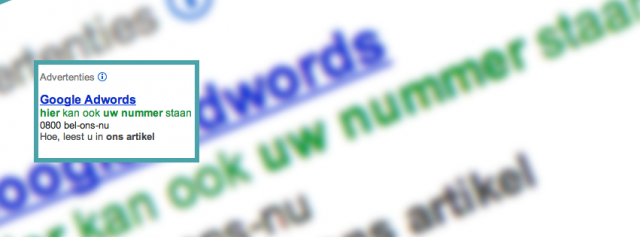Want Your Phone Number to Appear More Often in Google AdWords?

Securing a service number is one of the smartest things you can do as an organization. The national and professional impression is a significant step toward a larger market. But that doesn’t automatically mean you’ll get more callers. You’ll need to take action yourself.
For example, it’s important to communicate your service number as much as possible. In addition to well-known channels like business cards, email signatures, and your website, there are other opportunities you might not have considered. In this article, we focus on one specific advertising channel: Google Ads (formerly AdWords).
If you haven’t yet experimented with Google AdWords online ads, now might be a good time to start. As we explained in a previous article, these ads allow you to appear at the top of search results for your potential customers. Of course, you pay for this, but if your profit margin allows, you can gain significant business from this advertising channel.
Location and/or Phone Number in Your Ads
Google AdWords has long worked with extensions. These are additional pieces of information you can provide about your organization, such as your phone number, location, or the yellow stars that determine your seller rating. If you choose to share this information with Google, it can appear in your ads.
For example, until recently, Google displayed phone numbers in AdWords ads if businesses had activated this extension. Users of smartphones and tablets with calling capabilities could even call the number with a single tap. This feature isn’t going away, but Google has made some changes that could impact your AdWords campaigns. Read on to see what’s changing and what actions you can take.
What’s Changing
Since you pay per click on your ad, it’s in Google’s interest to maximize clicks on your ad. The same applies to ads from other businesses bidding on the same search term. While the amount businesses bid on keywords plays a role, Google determines the order of ads based on the expected total revenue.
Recently, Google has also started deciding which extensions to display. So it’s no longer a strict promise that smartphone users will see a call button and possibly a route description, but rather a ‘depends-on-the-situation’ approach. Based on experiences with other ads, Google chooses which extra information is most likely to generate clicks — the highest click-through rate (CTR).
What You Can Do
You might wonder whether this is good or bad news for you. We believe it’s good news because AdWords aims to help you achieve the highest possible CTR. However, this only works if you provide Google with as many extensions as possible, so the search engine can display them in situations where they increase the chances of more clicks.
Google increasingly shows the advertiser’s phone number for local searches, provided it’s a local number. So make sure to include that number, as well as your service number. If Google decides to show your number to users outside your region, they’ll see your service number instead of your local number.
If you want customers to visit you, be sure to include your address details. If you have more than 30 reviews on sites like Google Shopping, Google Trusted Stores, and StellaService, AdWords may choose to display an average customer rating in the form of stars.
Other extensions Google can use include:
- An app extension that links directly to your mobile or tablet app under your ad.
- An offer extension that displays a link to a discount code under your ad.
- Fill in the sitelinks to promote links to specific pages on your site.
- With social annotations, visitors can see how many followers you have on Google+.
In other words, the more extensions you fill in, the more tools Google has to make your ad perform well. More revenue for Google and more visitors to your website. And as people increasingly use mobile devices, your phone number will also appear more often in AdWords.

 Netherlands
Netherlands Belgium
Belgium Denmark
Denmark Germany
Germany France
France Switzerland
Switzerland Austria
Austria UK
UK Spain
Spain Italy
Italy


